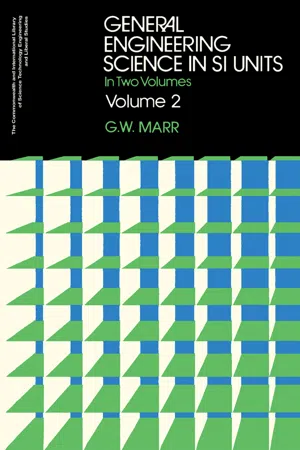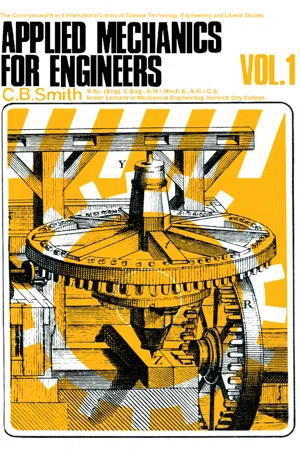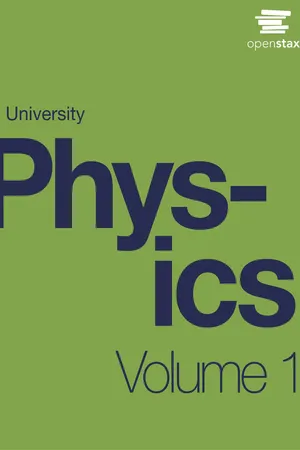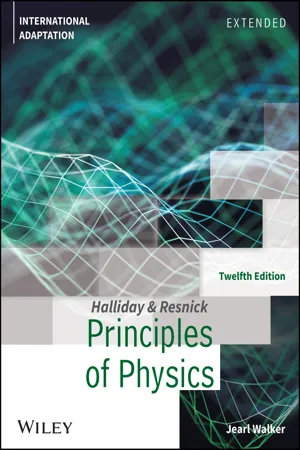Mathematics
Acceleration and Velocity
Acceleration is the rate of change of velocity over time, indicating how quickly an object's speed is changing. Velocity, on the other hand, is the rate of change of an object's position with respect to time, including both speed and direction. In mathematical terms, acceleration is the derivative of velocity with respect to time.
Written by Perlego with AI-assistance
Related key terms
1 of 5
12 Key excerpts on "Acceleration and Velocity"
- eBook - PDF
General Engineering Science in SI Units
The Commonwealth and International Library: Mechanical Engineering Division
- G. W. Marr, N. Hiller(Authors)
- 2013(Publication Date)
- Pergamon(Publisher)
Section 2 Velocity and Acceleration 2.1. Motion When the position of one body relative to another is continuously changing the bodies are said to be in relative motion. Motion, in fact, is always relative. In very many cases we are concerned with the motion of a body relative to the earth, and in such cases the word relative is generally omitted. We are accustomed to refer-ring simply to the motion of a motor vehicle or aircraft. We may say, for example, that a caj* is travelling at a speed of 30 km/h. When we do so, it must be understood that the speed is relative to the earth. 2.2. Velocity The velocity of a body is the rate at which the body is changing its position. Because direction is involved, velocity is a vector quantity. The magnitude, or numerical value, of a velocity is called the speed. The average speed of a body during a given interval of time IS measured by the ratio total distance^raven.d in given time W h e n a body travels equal distances during equal intervals of time, what-ever the magnitude of the time interval, the body is said to travel with constant speed. A velocity may change because of change in speed, or in the direction of motion or because of a change v in both of these. 32 VELOCITY AND ACCELERATION When a body moves in such a way that its velocity does not change, it is said to move with constant, or uniform, velocity. Hence to move with uniform velocity, a body must travel at constant speed in a straight line. EXAMPLE. A vehicle travels a distance of 840 m in 30 sec. Express its average speed in km/h. Distance travelled = 840 m = 0-84 km. 30 s = ai 0-84 km Time interval = 30s = g§öö h = iiö-h .*. average speed — —j = 100-8 km/h. EXAMPLE. The straight-line distance between two towns, A and B, is 49 km. Town A is due north-west from B. The road distance between the towns is 56 km. A motorist leaves A at 13.20 h and arrives at B at 14.10 h. Calculate (a) his average speed; (b) his average velocity. - eBook - PDF
General Engineering Science in SI Units
In Two Volumes
- G. W. Marr, N. Hiller(Authors)
- 2016(Publication Date)
- Pergamon(Publisher)
Section 2 Velocity and Acceleration 2.1. Motion When the position of one body relative to another is continuously changing the bodies are said to be in relative motion. Motion, in fact, is always relative. In very many cases we are concerned with the motion of a body relative to the earth, and in such cases the word relative is generally omitted. We are accustomed to refer-ring simply to the motion of a motor vehicle or aircraft. We may say, for example, that a car is travelling at a speed of 30 km/h. When we do so, it must be understood that the speed is relative to the earth. 2.2. Velocity The velocity of a body is the rate at which the body is changing its position. Because direction is involved, velocity is a vector quantity. The magnitude, or numerical value, of a velocity is called the speed. The average speed of a body during a given interval of time is measured by the ratio total distance um^d m given time w h e n a body travels equal distances during equal intervals of time, what-ever the magnitude of the time interval, the body is said to travel with constant speed. A velocity may change because of change in speed, or in the direction of motion or because of a change in both of these. 32 VELOCITY AND ACCELERATION When a body moves in such a way that its velocity does not change, it is said to move with constant, or uniform, velocity. Hence to move with uniform velocity, a body must travel at constant speed in a straight line. EXAMPLE. A vehicle travels a distance of 840 m in 30 sec. Express its average speed in km/h. Distance travelled = 840 m = 0-84 km. Time interval = 3 0 s = a|ööh = 1 ^-h 0-84 km .·. average speed = —j I2Ö h = 100-8 km/h. EXAMPLE. The straight-line distance between two towns, A and B, is 49 km. Town A is due north-west from B. The road distance between the towns is 56 km. A motorist leaves A at 13.20 h and arrives at B at 14.10 h. Calculate (a) his average speed; (b) his average velocity. - eBook - PDF
- Michael Tammaro(Author)
- 2019(Publication Date)
- Wiley(Publisher)
Hence- forth, when we refer to an object’s velocity, we mean its instantaneous velocity, with the magnitude of the instantaneous velocity being the object’s (instantaneous) speed. 2.4 Solve problems involving average acceleration, velocity, and time. 2.4.1 Interpret or determine the direction of the acceleration. If your friend tells you that her velocity has changed, what she probably means is that the magnitude of her velocity has increased or decreased; that is, the speed with which she is moving has changed. Your friend may use the word acceleration or deceleration when speaking about her changing speed. These words have very specific meanings in physics and, like velocity, the way they are used in everyday conversation is sometimes inconsist- ent with their scientific definitions. When an object’s velocity changes, we say that there is acceleration. Suppose that the velocity changes from v 0 to v in a time t t t 0 ∆ = − . We define the object’s average acceler- ation in the following way: a v t v v t t avg 0 0 = ∆ ∆ = − − (2.4.1) The SI unit of acceleration is / m s 2 . Acceleration is a vector quantity, so it has a magni- tude and a direction, with the direction of the acceleration being the same as the direction of the change in velocity. There is acceleration if there is a change in the direction of the velocity, in the magnitude of the velocity (i.e., the speed), or in both. To illustrate the use of Equation 2.4.1, consider the situation depicted in Animated Figure 2.4.1. A rocket, moving in the positive x direction, is coasting in space at a speed 2.4 ACCELERATION Learning Objectives Animated Figure 2.4.1 A rocket fires its forward thrusters and its speed increases. I N T E R A C T I V E F E A T U R E I N T E R A C T I V E F E A T U R E Acceleration | 51 A car is traveling at a speed of 21.8 m/s. The driver taps the brakes for 3.2 s during which time the magnitude of the average acceleration is 1.5 m/s 2 . - eBook - PDF
- John D. Cutnell, Kenneth W. Johnson, David Young, Shane Stadler(Authors)
- 2021(Publication Date)
- Wiley(Publisher)
It equals the change ∆ → v in the velocity divided by the elapsed time ∆t, the change in the velocity being the final minus the initial velocity; see Equation 2.4. When ∆t becomes infinitesimally small, the average acceleration becomes equal to the instantaneous acceleration → a , as Focus on Concepts 51 indicated in Equation 2.5. Acceleration is the rate at which the veloc- ity is changing. ¯ → a = ∆ → v ___ ∆t (2.4) → a = lim Δt→0 ∆ → v ___ ∆t (2.5) 2.4 Equations of Kinematics for Constant Acceleration/ 2.5 Applications of the Equations of Kinematics The equa- tions of kinematics apply when an object moves with a constant acceleration along a straight line. These equations relate the dis- placement x − x 0 , the acceleration a, the final velocity υ, the initial velocity υ 0 , and the elapsed time t − t 0 . Assuming that x 0 = 0 m at t 0 = 0 s, the equations of kinematics are as shown in Equations 2.4 and 2.7–2.9. υ = υ 0 + at (2.4) x = 1 _ 2 (υ 0 + υ)t (2.7) x = υ 0 t + 1 _ 2 at 2 (2.8) υ 2 = υ 0 2 + 2ax (2.9) 2.6 Freely Falling Bodies In free-fall motion, an object experi- ences negligible air resistance and a constant acceleration due to grav- ity. All objects at the same location above the earth have the same acceleration due to gravity. The acceleration due to gravity is directed toward the center of the earth and has a magnitude of approximately 9.80 m/s 2 near the earth’s surface. 2.7 Graphical Analysis of Velocity and Acceleration The slope of a plot of position versus time for a moving object gives the object’s velocity. The slope of a plot of velocity versus time gives the object’s acceleration. Focus on Concepts Online Time Position A B C QUESTION 8 Section 2.6 Freely Falling Bodies 6. A rocket is sitting on the launch pad. The engines ignite, and the rocket begins to rise straight upward, picking up speed as it goes. At about 1000 m above the ground the engines shut down, but the rocket continues straight upward, losing speed as it goes. - eBook - PDF
Applied Mechanics for Engineers
The Commonwealth and International Library: Mechanical Engineering Division
- C. B. Smith, N. Hiller, G. E. Walker(Authors)
- 2013(Publication Date)
- Pergamon(Publisher)
CHAPTER 4 Velocity and Acceleration Velocity Velocity is rate of change of position with respect to time, so it is necessary to specify its magnitude, direction and the datum with respect to which it is measured. EXAMPLE 4.1. A motor-car travelling along a straight road has a velocity of 60 mile/h or 88 ft/sec relative to the road. A second car approaching from the opposite direction has a velocity of 30 mile/h or 44 ft/s relative to the road. Then the velocity of the second car relative to the first car is 90 m.p.h. or 132 ft/s, which it will be seen is the difference between the velocities of the two cars relative to the road allowing for the fact that one car is going in the opposite direction to the other. Like force, a velocity is a vector quantity and may be represented by a line; the length of the line being the magnitude of the velocity and its position showing the direction. Problems in relative velocity may be dealt with either by cal-culation or by graphical construction. EXAMPLE 4.2. A cyclist is travelling due north at 15 mile/h in a wind blowing from the south-east at 20 mile/h. Find the direction in which a flag mounted on the front of his cycle will point. Calculation. Velocity of cycle relative to the ground in a northerly direction = 15 mile/h. Velocity of wind relative to ground in a northerly direction = 20 sin 45° = 20x0-7071 = 14-142 mile/h. 71 72 APPLIED MECHANICS FOR ENGINEERS Λ velocity of wind relative to cycle in a northerly direction = vel. of wind—vel. of cycle = 14-142-15 = -0-858 mile/h. Velocity of cycle relative to ground in a westerly direction = 0 mile/h. Velocity of wind relative to ground in a westerly direction = 20 cos 45° = 20x0-7071 = 14-142 mile/h. .*. velocity of wind relative to cycle in a westerly direction = 14-142-0 = 14-142 mile/h. .'. actual velocity of wind relative to cycle = y/( — 0-858) 2 + (14-142) 2 = 14-17 m.p.h. and this will be in a direction 14-142 t a n 1 — — — = t a n 1 -16-48^93° 31' W. - eBook - PDF
- James Shipman, Jerry Wilson, Charles Higgins, Bo Lou, James Shipman(Authors)
- 2020(Publication Date)
- Cengage Learning EMEA(Publisher)
Changes in motion can be sensed if they are appreciable. Think about being in a smooth-riding car and blindfolded. Minor changes in velocity would go unnoticed, but you would be able to tell if the car suddenly sped up, slowed down, or went around a sharp curve, all of which are changes in velocity. A change in velocity is called an acceleration, the topic of the following sections. Did You Learn? ● ● Speed is a scalar (magnitude), and velocity is a vector (magnitude and direction). ● ● Distance (actual path length) is always greater than or equal to the magnitude of displacement (straight-line distance). 2.3 Acceleration Key Questions ● ● What motional changes produce an acceleration? ● ● Is a negative acceleration (2a) necessarily a deceleration? When you are riding in a car on a straight interstate highway and the speed is suddenly increased—say, from 45 mi/h to 60 mi/h (72 km/h to 97 km/h)—you feel as though you are being forced back against the seat. If the car then whips around a circular cloverleaf, you feel forced to the outside of the circle. These experiences result from changes in velocity. Because velocity is a vector quantity, with both magnitude and direction, a change in velocity involves either or both of these factors. Therefore, an acceleration may result from 1. a change in speed (magnitude), 2. a change in direction, or 3. a change in both speed and direction. Copyright 2021 Cengage Learning. All Rights Reserved. May not be copied, scanned, or duplicated, in whole or in part. Due to electronic rights, some third party content may be suppressed from the eBook and/or eChapter(s). Editorial review has deemed that any suppressed content does not materially affect the overall learning experience. Cengage Learning reserves the right to remove additional content at any time if subsequent rights restrictions require it. 2.3 Acceleration 35 When any of these changes occur, an object is accelerating. - eBook - PDF
- William Moebs, Samuel J. Ling, Jeff Sanny(Authors)
- 2016(Publication Date)
- Openstax(Publisher)
Position from velocity and acceleration x = x 0 + v 0 t + 1 2 at 2 (constant a) Velocity from distance v 2 = v 0 2 + 2a(x − x 0 ) (constant a) Velocity of free fall v = v 0 − gt (positive upward) Height of free fall y = y 0 + v 0 t − 1 2 gt 2 Velocity of free fall from height v 2 = v 0 2 − 2g(y − y 0 ) Velocity from acceleration v(t) = ∫ a(t)dt + C 1 Position from velocity x(t) = ∫ v(t)dt + C 2 SUMMARY 3.1 Position, Displacement, and Average Velocity • Kinematics is the description of motion without considering its causes. In this chapter, it is limited to motion along a straight line, called one-dimensional motion. • Displacement is the change in position of an object. The SI unit for displacement is the meter. Displacement has direction as well as magnitude. • Distance traveled is the total length of the path traveled between two positions. • Time is measured in terms of change. The time between two position points x 1 and x 2 is Δt = t 2 − t 1 . Elapsed time for an event is Δt = t f − t 0 , where t f is the final time and t 0 is the initial time. The initial time is often taken to be zero. • Average velocity v – is defined as displacement divided by elapsed time. If x 1 , t 1 and x 2 , t 2 are two position time points, the average velocity between these points is v – = Δx Δt = x 2 − x 1 t 2 − t 1 . 3.2 Instantaneous Velocity and Speed • Instantaneous velocity is a continuous function of time and gives the velocity at any point in time during a particle’s motion. We can calculate the instantaneous velocity at a specific time by taking the derivative of the position function, which gives us the functional form of instantaneous velocity v(t). • Instantaneous velocity is a vector and can be negative. • Instantaneous speed is found by taking the absolute value of instantaneous velocity, and it is always positive. • Average speed is total distance traveled divided by elapsed time. - David Halliday, Robert Resnick, Jearl Walker(Authors)
- 2023(Publication Date)
- Wiley(Publisher)
The instantaneous acceleration (or simply acceleration) is a = dv ___ dt . (2.3.2) In words, the acceleration of a particle at any instant is the rate at which its velocity is changing at that instant. Graphically, the acceleration at any point is the slope of the curve of v(t) at that point. We can combine Eq. 2.3.2 with Eq. 2.2.1 to write a = dv ___ dt = d __ dt ( dx ___ dt ) = d 2 x ____ dt 2 . (2.3.3) In words, the acceleration of a particle at any instant is the second derivative of its position x(t) with respect to time. A common unit of acceleration is the meter per second per second: m/(s ⋅ s) or m/s 2 . Other units are in the form of length/(time ⋅ time) or length/time 2 . Accel- eration has both magnitude and direction (it is yet another vector quantity). Its algebraic sign represents its direction on an axis just as for displacement and velocity; that is, acceleration with a positive value is in the positive direction of an axis, and acceleration with a negative value is in the negative direction. Figure 2.2.1 gives plots of the position, velocity, and acceleration of an elevator moving up a shaft. Compare the a(t) curve with the v(t) curve—each point on the a(t) curve shows the derivative (slope) of the v(t) curve at the corresponding time. When v is constant (at either 0 or 4 m/s), the derivative is zero and so also is the acceleration. When the cab first begins to move, the v(t) curve has a positive derivative (the slope is positive), which means that a(t) is positive. When the cab slows to a stop, the derivative and slope of the v(t) curve are negative; that is, a(t) is negative. After reading this module, you should be able to . . . 2.3.1 Apply the relationship between a particle’s average acceleration, its change in velocity, and the time interval for that change. 2.3.2 Given a particle’s velocity as a function of time, calculate the instantaneous acceleration for any particular time.- eBook - PDF
- John D. Cutnell, Kenneth W. Johnson, David Young, Shane Stadler, Heath Jones, Matthew Collins, John Daicopoulos, Boris Blankleider(Authors)
- 2020(Publication Date)
- Wiley(Publisher)
In fact, in the limit that Δt becomes infinitesimally small, the instantaneous velocity and the average velocity become equal, so that v = lim Δt→0 Δ x Δt (2.3) The notation lim Δt→0 Δ x Δt means that the ratio Δ x∕Δt is defined by a limiting process in which smaller and smaller values of Δt are used, so small that they approach zero. As smaller values of Δt are used, Δ x also becomes smaller. However, the ratio Δ x∕Δt does not become zero but, rather, approaches the value of the instantaneous velocity. For brevity, we will use the word velocity to mean ‘instantaneous velocity’ and speed to mean ‘instantaneous speed’. 2.3 Acceleration LEARNING OBJECTIVE 2.3 Define one-dimensional acceleration. PHOTO 2.1 As this sprinter explodes out of the starting block, her velocity is changing, which means that she is accelerating. In a wide range of motions, the velocity changes from moment to moment, such as in the case of the sprinter in photo 2.1. To describe the manner in which it changes, the concept of acceleration is needed. The veloc- ity of a moving object may change in a num- ber of ways. For example, it may increase, as it does when the driver of a car steps on the gas pedal to pass the car ahead. Or it may decrease, as it does when the driver applies the brakes to stop at a red light. In either case, the change in velocity may occur over a short or a long time interval. To describe how the velocity of an object changes during a given time interval, we now introduce the new idea of acceleration. This idea depends on two concepts that we have previously encountered, velocity and time. Specifically, the notion of acceleration emerges when the change in the velocity is combined with the time during which the change occurs. The meaning of average acceleration can be illustrated by considering a plane during take-off. Figure 2.4 focuses attention on how the plane’s velocity changes along the runway. - eBook - PDF
Workshop Physics Activity Guide Module 1
Mechanics I
- Priscilla W. Laws, David P. Jackson, Brett J. Pearson(Authors)
- 2023(Publication Date)
- Wiley(Publisher)
(Do not erase your prediction.) How was your prediction? Briefly explain the reasons for any significant differences. c. How can you tell from a velocity-time graph that the moving object has changed direction? What is the velocity at the instant the object’s direction changes? d. We already noted that it is impossible to make perfectly vertical lines on a velocity-time graph. What about for a position-time graph? Is it possible to move your body (or an object) to make perfectly vertical lines on a position-time graph? Why or why not? e. Recall that velocity is defined to be the derivative of position with respect to time. Does this relationship appear to hold for the graphs in this activ- ity? Explain briefly. 80 WORKSHOP PHYSICS ACTIVITY GUIDE POSITION, VELOCITY, AND ACCELERATION 3.5 INTRODUCTION TO ACCELERATION In addition to position and velocity there is a third quantity that is useful when describing the motion of an object—acceleration. Similar to how we defined velocity from position, acceleration is defined as the rate of change of velocity with respect to time. Mathematically, acceleration is the derivative of velocity with respect to time: a = lim Δt→0 Δ Δt = d dt = d x dt x + d y dt y + d z dt z = a x x + a y y + a z z (3.4) Because of this definition, acceleration is a vector quantity, just like position and velocity. In this section, you will examine the acceleration of objects. Unfortunately, because acceleration is calculated from velocity-time data, which is calculated from position-time data, acceleration graphs are not as smooth as velocity graphs. The result is that it is very difficult to use your body to produce a smooth enough acceleration graph for analyzing. For this reason, it is easier to examine the motion of a cart moving on a track. For the activities in this section, you will need (Fig. 3.8): • 1 ultrasonic motion sensor interfaced to a computer • 1 low-friction cart • 1 cart track, 2 m 50 cm Fig. - eBook - PDF
- John D. Cutnell, Kenneth W. Johnson, David Young, Shane Stadler(Authors)
- 2018(Publication Date)
- Wiley(Publisher)
When ∆t becomes infinitesimally small, the average acceleration becomes equal to the 48 CHAPTER 2 Kinematics in One Dimension instantaneous acceleration a → , as indicated in Equation 2.5. Acceleration is the rate at which the velocity is changing. a → = ∆v → ∆t (2.4) a → = lim ∆ t →0 ∆ v → ∆t (2.5) 2.4 Equations of Kinematics for Constant Acceleration/2.5 Applications of the Equations of Kinematics The equations of kinematics apply when an object moves with a constant acceleration along a straight line. These equa- tions relate the displacement x − x 0 , the acceleration a, the final velocity υ, the initial velocity υ 0 , and the elapsed time t − t 0 . Assuming that x 0 = 0 m at t 0 = 0 s, the equations of kinematics are as shown in Equations 2.4 and 2.7–2.9. υ = υ 0 + at (2.4) x = 1 2 (υ 0 + υ) t (2.7) x = υ 0 t + 1 2 at 2 (2.8) υ 2 = υ 2 0 + 2ax (2.9) 2.6 Freely Falling Bodies In free-fall motion, an object experiences neg- ligible air resistance and a constant acceleration due to gravity. All objects at the same location above the earth have the same acceleration due to gravity. The acceleration due to gravity is directed toward the center of the earth and has a magnitude of approximately 9.80 m/s 2 near the earth’s surface. 2.7 Graphical Analysis of Velocity and Acceleration The slope of a plot of position versus time for a moving object gives the object’s velocity. The slope of a plot of velocity versus time gives the object’s acceleration. Note to Instructors: The numbering of the questions shown here reflects the fact that they are only a representative subset of the total number that are available online. However, all of the questions are available for assignment via WileyPLUS. Section 2.1 Displacement 1. What is the difference between distance and displacement? (a) Distance is a vector, while displacement is not a vector. (b) Displacement is a vector, while distance is not a vector. - eBook - PDF
- John Matolyak, Ajawad Haija(Authors)
- 2013(Publication Date)
- CRC Press(Publisher)
25 © 2010 Taylor & Francis Group, LLC Motion in One Dimension This chapter addresses deriving and using the equations of motion that describe the time depen-dence of an object’s displacement, velocity, and acceleration. Relationships between displacement, velocity, and acceleration are also of importance and will be derived. This chapter starts with the basic definitions of displacement and average velocity of an object moving in one dimension. Such a simplified start will help to lead a complete set of equations of motion for an object moving along one dimension, east–west, north–south, or up and down. In the context of coordinate systems that were treated in the previous chapter, the one-dimensional motion will reduce the time and effort needed on the study of motion in two dimensions, which is the subject of the next chapter. 2.1 DISPLACEMENT Motion can be defined as a continuous change in position and that change could occur in one, two, or three dimensions. As the treatment here will be limited to motions only in one dimension, one axis of the coordinate system described in Chapter 1 will suffice. Choosing this axis as the x-axis, we depict on it a point, O, which will be considered as an origin of zero coordinate. Any point on the right of the origin O will have a positive coordinate and any point on the left of O will have a negative coordinate (Figure 2.1). The displacement, denoted by Δ x, of an object as it moves from an initial position x i to a final position x f along the x-axis can be defined as the change in the object’s position along the x-axis. That is Δ x = x f – x i . (2.1) 2.1.1 S PECIAL R EMARKS The quantities in Equation 2.1 are treated as vectors. x i is the initial position vector, x f the final posi-tion vector, and Δ x the displacement vector. Accordingly, all these quantities have a direction and magnitude.
Index pages curate the most relevant extracts from our library of academic textbooks. They’ve been created using an in-house natural language model (NLM), each adding context and meaning to key research topics.











